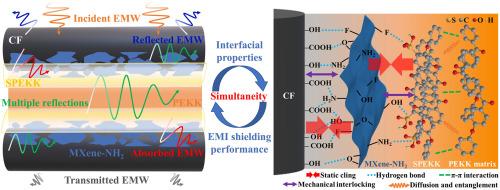Synergistic enhancement of EMI shielding and interfacial properties in CF/PEKK composites via electrostatic self-assembly of aminated MXene and SPEKK
IF 9.8
1区 材料科学
Q1 MATERIALS SCIENCE, COMPOSITES
引用次数: 0
Abstract
Structural-functional integrated composites represent a key trend in aerospace and smart manufacturing applications. In this work, inorganic two-dimensional MXene (Ti3C2Tx) synergistic organic sulfonated polyetherketoneketone (SPEKK) was employed to increase the EMI shielding and interfacial properties of carbon fiber reinforced polyetherketoneketone (CF/PEKK) composites via electrostatic self-assembly. By means of static cling, the aminated MXene (MXene-NH2) with positive charge and negatively charged SPEKK were sequentially assembled on the negatively charged CF surfaces to form an effective interfacial layer. Subsequently, CF/PEKK composites were prepared by molding process. The resultant CF/PEKK composites achieved superior EMI shielding effectiveness of 44.6 dB, which was 60.4 % higher than that of unmodified CF/PEKK composites. The improvement of the shielding effectiveness might be due to increased interfacial polarization losses, ohmic losses and dipole polarization losses of the CF/PEKK composites by MXene-NH2 and SPEKK against electromagnetic waves. Simultaneously, the flexural strength, flexural modulus and interlaminar shear strength of CF/PEKK composites achieved 1233 MPa, 86.47 GPa and 92 MPa, which were 35.0 %, 16.1 % and 26.0 % above those of virgin CF/PEKK composites, respectively. Such promotion in mechanical properties could originate from the comprehensive effect of static cling, hydrogen bonding and mechanical interlocking between MXene-NH2 and CF, SPEKK, as well as π-π interactions, diffusion and entanglement between SPEKK and polyetherketoneketone (PEKK). Briefly, this study puts forward an effective interfacial modification technique for developing carbon fiber-reinforced thermoplastic composites with integrated structural and functional properties.

胺化MXene和SPEKK静电自组装协同增强CF/PEKK复合材料的EMI屏蔽和界面性能
结构功能一体化复合材料是航空航天和智能制造应用的一个重要趋势。本文采用无机二维MXene (Ti3C2Tx)协同有机磺化聚醚酮(SPEKK),通过静电自组装提高碳纤维增强聚醚酮(CF/PEKK)复合材料的电磁屏蔽性能和界面性能。通过静电粘接的方法,将带正电荷的胺化MXene (MXene- nh2)和带负电荷的SPEKK依次组装在带负电荷的CF表面,形成有效的界面层。随后,采用模压法制备了CF/PEKK复合材料。合成的CF/PEKK复合材料的EMI屏蔽效率为44.6 dB,比未改性的CF/PEKK复合材料提高了60.4%。屏蔽效果的提高可能是由于MXene-NH2和SPEKK增加了CF/PEKK复合材料对电磁波的界面极化损耗、欧姆损耗和偶极子极化损耗。同时,CF/PEKK复合材料的抗弯强度、抗弯模量和层间剪切强度分别达到1233 MPa、86.47 GPa和92 MPa,分别比原CF/PEKK复合材料提高了35.0%、16.1%和26.0%。MXene-NH2与CF、SPEKK之间的静态粘接、氢键和机械互锁,以及SPEKK与聚醚酮酮(PEKK)之间的π-π相互作用、扩散和缠结等综合作用,对材料的力学性能产生了促进作用。简要地说,本研究提出了一种有效的界面改性技术,用于开发集结构和功能于一体的碳纤维增强热塑性复合材料。
本文章由计算机程序翻译,如有差异,请以英文原文为准。
求助全文
约1分钟内获得全文
求助全文
来源期刊

Composites Science and Technology
工程技术-材料科学:复合
CiteScore
16.20
自引率
9.90%
发文量
611
审稿时长
33 days
期刊介绍:
Composites Science and Technology publishes refereed original articles on the fundamental and applied science of engineering composites. The focus of this journal is on polymeric matrix composites with reinforcements/fillers ranging from nano- to macro-scale. CSTE encourages manuscripts reporting unique, innovative contributions to the physics, chemistry, materials science and applied mechanics aspects of advanced composites.
Besides traditional fiber reinforced composites, novel composites with significant potential for engineering applications are encouraged.
 求助内容:
求助内容: 应助结果提醒方式:
应助结果提醒方式:


